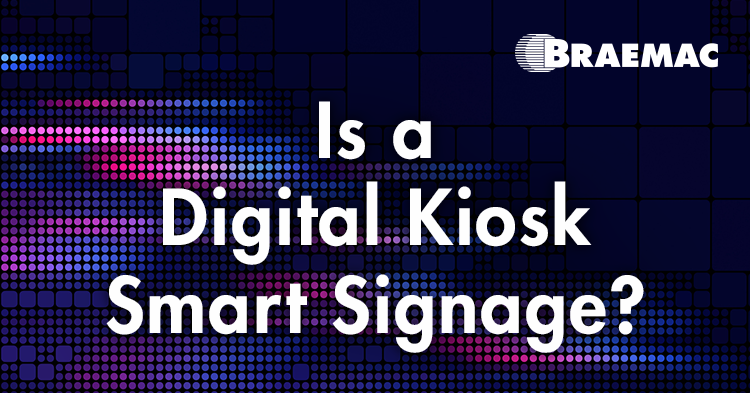- Home
- Braemac Blog
- Is a Digital Kiosk Smart Signage?
Is a Digital Kiosk Smart Signage?
About Jari Haiston

The Short Answer: Yes, technically, digital kiosks are a subset of smart signage.
However, the longer answer is far more interesting. Digital signage does more than display information. It interacts, transacts, guides, and personalizes. Merging customer engagement with real-time data, digital kiosks transform simple screens into powerful computing endpoints.
Digital Kiosks vs Smart Signage
| Feature | Digital Kiosk | Smart Signage |
| Touchscreen Interactivity | Often | Sometimes |
| Passive Content Playback | Sometimes | Core Function |
| Context Aware Content | With Sensors/CMS | Expected |
There's overlap between smart signage and digital kiosks, but their primary functions differ:
- Digital kiosks are interactive terminals designed for transactions, search, ticketing, ordering, and user-driven engagement.
- Smart signage is content-forward, and purpose-built to broadcast dynamic, adaptive, real-time information.
A digital kiosk becomes smart signage when it displays context-aware or idle-state content, integrates with a CMS, or uses sensors to adapt visuals or promotions dynamically.
What Makes Signage Smart?
Smart signage goes far beyond basic content loops. It’s dynamic, data-driven, integrated, and a far cry from static digital posters.
Today’s intelligent signage systems are:
| 1. Context Aware | 2. Remotely Managed | 3. Interactive or Automated |
Smart signage adapts based on:
| A modern CMS enables:
| Even non-touch signage can respond to triggers such as:
|
What is a Digital Kiosk?
Digital kiosks are interactive, embedded computer systems used for task-oriented applications such as:
- Self check-in and ticketing in airports, transit hubs, and events
- Wayfinding and navigation in malls, campuses, and corporate buildings
- Product lookup and ordering for retail and QSR
- Patient check-in and educational content in healthcare
Kiosks typically include touchscreens, peripherals (scanners, printers, card readers), cameras, sensors, and often run full embedded Linux or Android OS.
When Does a Kiosk Become Smart Signage?
Often integrating touchscreens, peripherals like printers and scanners, and custom applications, digital kiosks can serve as smart signage when idle or contextually responsive. For example, when a kiosk displays promotional content while idle, adapts based on user behavior, or integrates your signage CMS, it’s not just a kiosk, it’s smart signage with a job to do.
A kiosk operates as smart signage when:
- It displays promotional content in idle mode
- It adjusts visuals based on user behavior
- It integrates with signage CMS platforms
- It uses sensors or analytics to adapt content
Retail
- A self-checkout kiosk showing seasonal promotions when inactive.
- End-cap product kiosks that automatically highlight related items.
Transit
- Ticketing kiosks that display real-time train arrivals.
- Interactive maps that scale signage content to travel conditions.
Healthcare
- Patient check-in kiosks that double as educational displays.
- Contextual messaging triggered by wait times or queue lengths.


Smart Signage and Digital Kiosk Design Solutions Available at Braemac Americas
As a global distributor, Braemac Americas is uniquely aware that future-proof kiosk designs demand AI/ML-driven personalization, reliable wireless connectivity, and efficient low-power edge processing to deliver seamless, responsive user experiences. They must also maintain strict industrial-grade security to protect data and system integrity. Our comprehensive portfolio includes a wide range of solutions that help developers ensure long-term viability.
- Industrial i.MX 93 single/dual-core embedded SOM platform
- AI/ML Arm Ethos U65 micro neural processing unit (NPU)
- Pre-certified dual-band 802.11ax Wi-Fi 6 and Bluetooth 5.2
- Digi SMTplus® form factor (40 x 45 mm) for ultimate reliability
- Superior power management, hardware and software support
- Seamless cellular modem and Digi XBee® integration
- High level of pin-compatibility with Digi ConnectCore 8 SOMs
- Built-in Digi TrustFence device security, identity and privacy
- Remote management with Digi ConnectCore Cloud Services
- Digi Embedded Yocto Linux support
- Fully standards compliant SDI interface bridging to and from HDMI 2.0
- Support for 4K video formats up to 60Hz at 10-bit 4:2:2 sampling
- Converts between Single-Link and Multi-Link SDI interfaces from HD-SDI to 12Gb/s UHD-SDI
- Three modes of operation:
- SDI to HDMI Bridge Mode
- HDMI to SDI Bridge Mode
- SDI to SDI Gearbox Mode
- Supports up to 16 channels of digital audio de-embedding and embedding at 48kHz or 96kHz
- Simultaneous de-embedding and embedding in all modes of operation
- Dedicated AES/EBU or I2S serial digital audio inputs and outputs
Yes. Digital kiosks are a subset of smart signage, especially when they display context-aware content, integrate with a CMS, or adapt visuals based on user behavior or sensor input.
How do digital kiosks differ from smart signage?
Digital kiosks are interactive, task-driven systems designed for check-in, ordering, navigation, and transactions. Smart signage is primarily content-focused, delivering dynamic, adaptive, real-time visuals to inform or influence audiences.
When does a kiosk “become” smart signage?
A kiosk functions as smart signage when idle screens play promotions, when content changes based on user interactions or environmental data, or when the kiosk is connected to a digital signage CMS.
What makes signage “smart”?
Smart signage is context-aware, cloud-managed, and capable of responding to environmental triggers such as motion, audience analytics, API data, or real-time operational updates.
What components do kiosks and smart signage typically rely on?
Both systems may include embedded processors, touch interfaces, cameras, wireless modules, sensors, and dedicated peripherals such as printers, card readers, or scanners.
Which applications commonly use digital kiosks?
Self-check-in, ticketing, wayfinding, retail ordering, product lookup, patient check-in, and educational content delivery.


